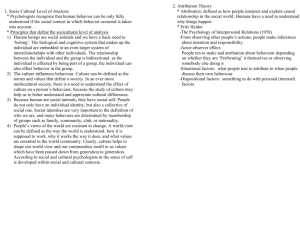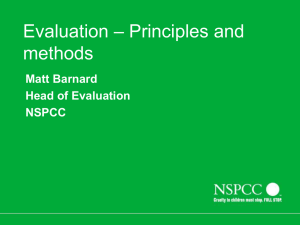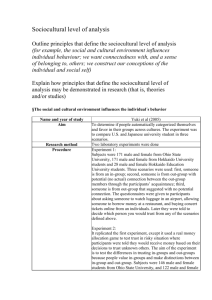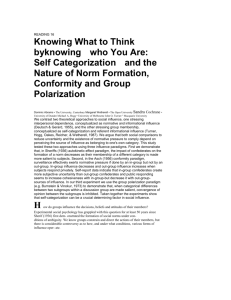Social Psychology PP Presentation
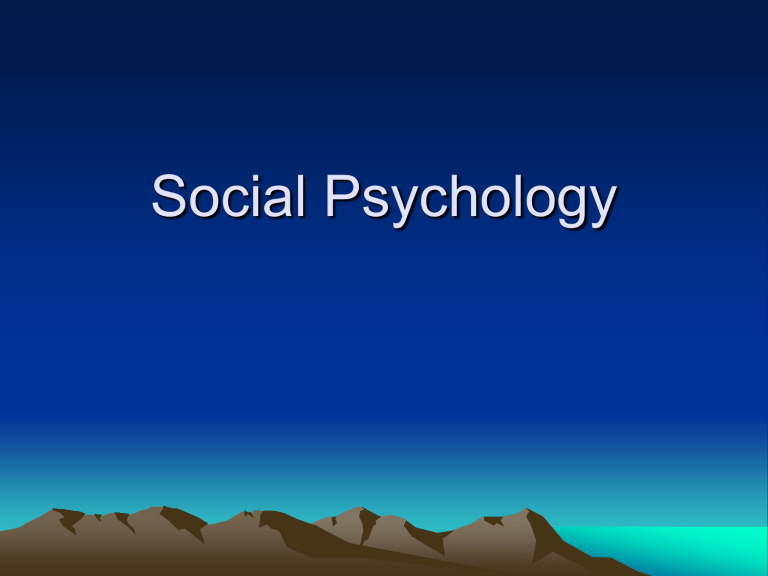
Social Psychology
Before reading this lecture, please be sure to watch a short video clip on :
• Phillip Zimbardo's Stanford Prison
Experiment on You Tube. The web address is: http://www.youtube.com/watch?v=rmwSC
5fS40w
• Social Psychology highlights that we as humans are social animals.
• This field also highlights how we perceive, judge, and influence each other.
• This chapter is term heavy so throughout this presentation, I provide the terms along with definitions and examples. Some examples are based on race and others on the Stanford Prison
Experiment, among other examples.
What is Social Psychology?
Social Psychology
Is the branch of psychology that studies how people think, feel, and behave in social situations.
What is Social Cognition?
Social Cognition
Is the mental processes people use to make sense out of their social environment. How people perceive, remember and interpret information about themselves and others. How people’s emotions, and motivations influence the cognitive process and vice versa.
What is Social Influence?
Social Influence
• Highlights the changes in a person’s behavior induced by the presence or actions of others.
Social Influence
Here are several examples:
• A person is looking up at a tall building on the street, others passing by also look up.
• A couple of kids tease a classmate, and other kids join in.
• One prison guard starts to be more stern, the other ones follow suit.
What is Person Perception?
Person Perception
• Is the mental processes we use to form judgments and draw conclusions about the characteristics and motives of other people.
Person Perception
Again here are two examples
• Parents are often surprised to hear that their mischievous child, the family monster, is a perfect angel in the classroom.
• Students are often surprised to observe that their favorite professor, so eloquent in the lecture hall, may stumble over words in less formal gatherings.
What are Social Norms?
Social Norms
• Are an accepted (but often unspoken) standard for appropriate behavior. May vary from culture to culture.
Can you think of any social norms that exist in this country or other countries?
Social Norms
Here are some examples
• In U.S. say excuse me when interrupt someone else; eat with mouth closed.
• In Asian countries take off shoes upon entering house.
• In Latin American and European countries, people might kiss each other on the cheek upon greeting once, twice, three times and sometimes even four times!
• It is normal for the prison guards to bark orders and be emotionless while prisoners follow orders.
What is Social Categorization?
Social Categorization
• Is the mental process of categorizing people into groups (or social categories) on the basis of t heir shared characteristics.
• Each person belongs to various social categories.
Social Categorization
Some examples include:
• Male, female, black, white, fat, skinny, short, tall, nerd, cool, prison guard, prisoner.
• Question: are these fixed categories? Are there exceptions? If so, what are they?
• Can one person’s social categorizing conflict with another’s?
What is Implicit Personality Theory?
Implicit Personality Theory
• Is a network of assumptions or beliefs about the relationship among various types of people, traits, and behaviors.
• Knowing that someone has one trait thus leads us to infer that s/he has other traits as well.
Implicit Personality Theory
Examples
• A person who speaks slowly is also slowwitted
• A sports hero like O.J. could not possibly stab two people to death
• A Catholic priest could never molest little boys.
What is Attribution?
Attribution
• Is the mental process of inferring the causes of people’s behavior, including one’s own. Also refers to the explanation made for a particular behavior.
• There are two categories:
– personal attribution, and
– situational attribution
Attribution
For Example:
• Imagine a hockey game where one player hits another —Do you attribute his hitting behavior to him and say “he is one of the league’s most violent players”? If so, then you just made a personal attribution. Or, likewise, you could say that “hockey is a very physical and fastpaced sport” and this then is a situational attribution.
• Another example is, let’s say that a white man complains that his daughters are not getting into college. He believes this is because people of color are getting in through affirmative action, which is a situational attribution; what if someone else were to say they should just try harder? This would then be a personal attribution.
• Many people of color experience this in terms of affirmative action —they got in because of the situation, not because one has the merit
(personal).
• In terms of the Stanford Prison
Experiment, did the prisoners and prison guards follow orders because they were told to take on these roles (situational attribution), or is there something inherently meek or stern about them, respectively.
What is Fundamental Attribution
Error?
Fundamental Attribution Error
• Is the tendency to attribute the behavior of others to internal causes (personality, likes, and so forth), while ignoring or underestimating the effects of external, situational factors.
• People fall prey to the fundamental attribution error even when they are fully aware of the situation’s impact.
Fundamental Attribution Error
For Example:
• You are waiting in line at the airport when someone cuts you off. Internally you think, this guy is a real jerk! How rude!
• Do you see that we are attributing his behavior to internal causes, as if something is inherently wrong with him? Attributing his behavior to internal causes is generally an automatic first step.
• Then you over hear him say that this is an emergency and he is in a rush because his mother is at her death bed. Then, we usually take this information into account and consider the situation, which is considered to be the effortful second step.
Two other examples:
• A person of color is viewed as lazy instead of considering discrimination/glass ceiling/policies keeping people of color out.
• A person is late to work because s/he is irresponsible vs. there being an actual traffic or family emergency.
• Can you think of any examples for fundamental attribution error?
What is Blaming the Victim?
Blaming the Victim
• Is the tendency to blame an innocent victim of misfortune for having somehow caused the problem or for not having taken steps to avoid or prevent it.
Blaming the Victim
Examples
• A young woman was raped and we blame her for the revealing clothes she wore.
• Poor people are blamed for causing their own predicament of social/economic inequalities.
• HIV/AIDS victims are blamed for irresponsible sexual practices instead of considering poor education or lack of access to resources or simply not knowing their partner had HIV/AIDS.
What is Just-World Hypothesis?
Just-World Hypothesis
• Is the assumption that the world is fair and that therefore people get what they deserve and deserve what they get, an orientation that leads people to disparage victims.
• A world where hard work and clean living always pay off and where laziness and a sinful lifestyle are punished. To believe otherwise is to concede that we, too, are vulnerable to the cruel twists and turns of fate.
Examples
Just-World Hypothesis
• “Why can’t you pull yourself up by your bootstraps.”
• The prison guard treating the prisoner like dirt because he committed a crime and thus deserves inhuman treatment.
• A white man saying “I worked hard to get where I am, why can’t you (person of color/woman) do the same.”
• The belief that gay men with AIDS lack moral integrity.
• Battered wives provoke their violent and abusive husbands.
What is Actor-Observer Discrepancy or Actor-Observer Bias?
Actor-Observer Discrepancy/Actor-
Observer Bias
• In making attributions, the tendency to attribute the behavior of others to internal causes while attributing one’s own behavior to external causes (situations and circumstances).
Actor-Observer Discrepancy/Actor-
Observor Bias
For Example:
• When you are late, you say “there was so much traffic”
(external cause), however, when another is late it is because s/he is irresponsible (internal cause).
• Or, when you break a glass it is because the glass was wet and slippery (external cause), however, when another breaks a glass, it is because s/he is clumsy
(internal cause).
• For the Stanford Prison Experiment, one prisoner who obeyed a prison guard says it is because the prison guard was really daunting (external cause), while he could judge another obeying prisoner as a pushover
(internal cause).
What is Self-Serving Bias?
Self-Serving Bias
• Is the tendency to attribute successful outcomes of one’s own behavior to internal causes and unsuccessful outcomes to external situational causes.
Self-Serving Bias
Examples
• A student gets an “A” on a test, so s/he feels great, intelligent, and studied hard. However, if the student did not do well, then it is because the teacher grades too hard, the test was too difficult, or there was not enough time, etc.
• You get a raise and believe this is because of all the stellar work you have done; you don’t get a raise and your boss is a total cheap skate.
What is an Attitude?
An Attitude is
• A learned tendency to evaluate some object, person, or issue in a particular way; such evaluations may be positive, negative, or ambivalent.
Attitude
Examples:
• like, love, dislike, hate, admire, and detest.
• You can either be favorable towards something, against it, ambivalent, or like multiple things equally.
What is Cognitive Dissonance?
Cognitive Dissonance
• Is an unpleasant state of psychological tension or arousal ( dissonance) that occurs when two thoughts or perceptions
(cognitions) are inconsistent; typically results from the awareness that attitudes and behavior are in conflict.
• Holding inconsistent cognitions arouses psychological tension that people become motivated to reduce.
Cognitive Dissonance
• For example, you are on a diet and just dived head first into a chocolate mousse.
• What do you do? How would you reduce the tension that exists due to the contrasting behavior and cognition?
Some possibilities include:
• Say “Life is too short, who needs to be on a diet any way!” (changing your cognition)
• I’ll exercise extra tomorrow or skip a meal
(change your behavior, still staying firm to the diet)
• Rationalize your behavior and say that chocolate mousse is highly nutritious (still staying firm to the diet)
• As you see, we can either change our behavior or our cognition so that they are aligned and the tension is reduced.
What is Prejudice?
Prejudice
• Is a negative attitude toward people who belong to a specific social group.
• It is a behavior (unlike the next concept, stereotype).
What is a Stereotype?
Stereotypes
• Are a cluster of characteristics that are associated with all members of a specific social group. Stereotypes are thoughts and we can simply notice them in our minds, however, once we act on them, then that becomes prejudice (the behavior).
Stereotypes
• Interestingly enough, we tend to remember stereotype consistent information more than stereotype inconsistent information. This is known as confirmation bias.
• For example, if someone on the freeway is driving slowly, and we happen to look over and the person is Asian, we remember that information more than noticing all the other
Asians who don’t drive slowly.
• What are the stereotypes you might hold or were taught by your family or society? Might any of these stereotypes fall under confirmation bias?
What is In-Group?
In-Group
• Is a social group to which one belongs and feels a sense of membership. Basically, whom you identify with.
In-Group
• For example, if you are Middle Eastern, then your in-group includes others that are also from the Middle East or identify as
Middle Eastern.
• One way to discover who your in-group is, and we actually can have many, is when you refer to “us”.
What is Out-Group?
Out-Group
• A social group to which one does not belong.
Out-Group
• A social group to which one does not belong.
Out-Group
• Let’s take the same example of the individual who identifies as Middle-Eastern and, as a result, her in-group would be comprised of other Middle Easterners. If you don’t identify as Middle Eastern, then from the Middle Easterners stand point, you are part of the out-group.
• One way to help you identify the out-group is when the term “them” or “they” is used.
What is Out-Group Homogeneity
Effect?
Out-Group Homogeneity Effect
• Is the tendency to see members of outgroups as very similar to one another and one’s own in-group as having more variety due to little personal contact and familiarity.
Out-Group Homogeneity Effect
Examples
• If you don’t identify as Asian, then Asian is your out-group, as a result, All Asians look alike from outsiders, but many Asians can tell the difference between Koreans, Japanese,
Chinese, and Vietnamese (here identifying as
Asian is one’s in-group).
• New Yorkers praise their cultural diversity (New
Yorker is your in-group), but outsiders talk of the
“typical” New Yorker (from the out-group’s perspective).
What is In-Group Bias?
In-Group Bias
• Is the tendency to judge the behavior of in-group members favorably and out-group members unfavorably.
• Terms used for in-groups (ie. we and us) tend to illicit positive emotions whereas terms used to describe out-groups (ie. them and they) tend to illicit negative emotions.
• The positive aspect of in-group bias is that there is pride from our connections; the negative aspect is that we often feel the need to belittle
“them” to feel good about “us”.
In-Group Bias
Examples
• Racial/ethnic conceit
• Religious fervor
• Patriotism
Ethnocentrism
Ethnocentrism
• The belief that one’s own culture or ethnic group is superior to all others and the related tendency to use one’s own culture as a standard by which to judge other cultures.
Ethnocentrism
Examples
• When the European settlers came to this land and believed they were civilizing the native heathens.
• Some believe that the Iraqi war is ethnocentric on the U.S.’s part – as some believe we tried to go there to make them have a democracy like us.
• What is considered normal? Who decides?
This concludes the end of our
Social Psychology lesson. Next:
• Take the Social Psychology multiple choice quiz.
• And, participate in the discussion forum.

